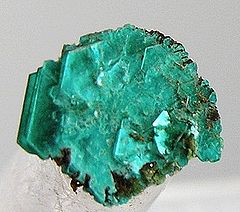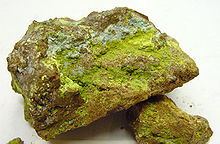- Chalcophyllite
-
Chalcophyllite 
Chalcophyllite from the Ting Tang Mine, Carharrack, Cornwall, England. Photo by Rob LavinskyGeneral Category Arsenate minerals Chemical formula Cu18Al2(AsO4)4(SO4)3(OH)24·36(H2O)[1][2][3] or
Cu18Al2(AsO4)3(SO4)3(OH)27·33(H2O)[4][5][6]Strunz classification 08.DF.30 Dana classification 43.5.14.1 Identification Color Blue-green to emerald-green Crystal habit Crystals platy and six-sided, also as rosettes, drusy, foliated or massive. Crystal system Trigonal, 3 2/m[5] or 3 [2][3][4][6] Twinning On {1010} as twin plane. Cleavage Perfect on {0001} Fracture Irregular Mohs scale hardness 2 Luster Vitreous to subadamantine, pearly on {0001} Streak Pale green Diaphaneity Transparent to translucent Specific gravity 2.67 to 2.69[3][4][6] or 2.4 to 2.66[5] Optical properties Uniaxial (-) Refractive index nω = 1.618 to 1.632, nε = 1.552 to 1.575 Pleochroism O blue-green, E almost colorless Solubility Soluble in acids and in ammonia. Other characteristics Can be partially dehydrated. Alters to chrysocolla. Nonfluorescent, not radioactive References [3][4][5][6] Chalcophyllite is a rare secondary copper arsenate mineral occurring in the oxidized zones of some arsenic-bearing copper deposits. It was first described from material collected in Germany. At one time chalcophyllite from Wheal Tamar in Cornwall, England, was called tamarite, but this name is now discredited[2] (not to be confused with the amphibole mineral taramite, which is quite different). At Wheal Gorland a specimen exhibiting partial replacement of liriconite, Cu2Al(AsO4)(OH)4.4(H2O), by chalcophyllite has been found.[2] The mineral is named from the Greek, chalco "copper" and fyllon, "leaf", in allusion to its composition and platy structure. It is a classic Cornish mineral that can be confused with tabular spangolite.
Contents
Formula
Two different formulae are quoted in the literature for chalcophyllite, Cu18Al2(AsO4)4(SO4)3(OH)24·36(H2O)[1][2][3] (molar mass 3098 g) and Cu18Al2(AsO4)3(SO4)3(OH)27·33(H2O)[4][5][6] (molar mass 2956 g). The difference reflects the fact that the water content varies at room temperature based on relative humidity.[4]
Unit cell
Chalcophyllite crystallizes in the trigonal crystal class, 3 2/m with space group R 3m[5] or 3 with space group R 3.[2][3][4][6] Some authors choose a unit cell with three formula units per cell (Z=3), and some a smaller unit cell with only 1.5 formula units per cell (Z=1.5). For the larger unit cell a = 10.77 Å, c = 57.5 Å, Z=3.[5][6][7] For the smaller unit cell c is only half as long, a = 10.756 Å, c = 28.678 Å, Z = 1.5.[3][4]
Crystal habit
Crystals are platy, six-sided and flattened perpendicular to the c crystal axis, and may be striated triangularly on these flattened faces. It may form rosettes, or be drusy, foliated or massive.[4]
Physical properties
 Chalcophyllite from Lemhi County, Idaho
Chalcophyllite from Lemhi County, Idaho
Cleavage is perfect perpendicular to the c crystal axis, and twinning occurs with {1010} as the twin plane. Fracture is irregular. The mineral is soft, with hardness only 2, the same as gypsum. Specific gravity is generally given in the range 2.67 to 2.69, but Webmineral has 2.4 to 2.66. Chalcophyllite is soluble in acids and in ammonia. It is not fluorescent, nor radioactive. The water content varies at room temperature based on relative humidity. Chalcophyllite alters to chrysocolla,[4] which is a copper-aluminium silicate with the formula (Cu,Al)2H2Si2O5(OH)4·n(H2O).
Optical properties
Many copper minerals are blue or green in color; chalcophyllite is blue-green to emerald-green, with a pale green streak and vitreous to subadamantine luster, pearly on {0001}. Crystals are transparent to translucent. It is uniaxial (-) with refractive indices nω = 1.618 to 1.632 and nε = 1.552 to 1.575. Indices of refraction vary markedly depending on the relative humidity since the water content varies at ambient temperature.[4] It is pleochroic with O blue-green and E almost colorless.
Environment
Chalcophyllite is an uncommon secondary mineral occurring in the oxidized zones of some arsenic-bearing hydrothermal copper deposits. Associated minerals include azurite, malachite, brochantite, chrysocolla, spangolite, connellite, cuprite, cyanotrichite, strashimirite, parnauite, lavendulan, cornubite, langite, clinoclase, pharmacosiderite and mansfieldite.[3] The type material is conserved at the Mining Academy, Freiberg, Germany.[3] Notable occurrences include the Majuba Hill Mine, Antelope District, Nevada, USA[2] and Cornwall, including Wheal Gorland, UK.
See also
References
- ^ a b http://rruff.info/ima
- ^ a b c d e f g Rocks & Minerals (2009) 84-5: 434 to 440
- ^ a b c d e f g h i Handbook of Mineralogy
- ^ a b c d e f g h i j k Mindat.org
- ^ a b c d e f g Webmineral data
- ^ a b c d e f g Gaines et al(1997) Dana's New Mineralogy, Wiley
- ^ Corbett (1973) American Mineralogist 58: 792–793
External links
Categories:- Arsenate minerals
- Copper minerals
- Trigonal minerals
Wikimedia Foundation. 2010.
